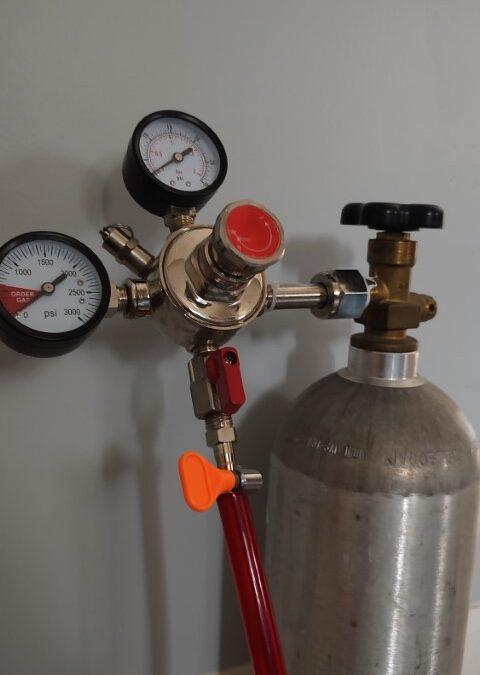Like so many homebrewers, when I first started kegging and working with CO2 tanks, I was super excited to take on this new chapter in my brewing adventures. What could be more exciting than being able to speed up packaging day and show off by having your amazing beer flowing out of a tap?
You’ve gotten your mini-fridge keezer now holding a keg or two. You’ve drilled a hole in the side so you can keep your CO2 tank on the outside allowing you to maximize the number of kegs you can fit inside.
Side Note: If you have room for a 10 or 20 LB CO2 tank, get that. It’s more expensive to start, but much cheaper in the long run. The difference in cost for exchanges is negligible. The last time I compared them in my area, a 5LB exchange was $30 and a 20LB was a mere $5 more at $35.
The kegs are fully carbonated, and you have a picnic tap on each keg. You pull a full perfect pint and feel exhilarated! Friends are over and enjoying your tasty beers! Life is sudsy great!
Then one day, far too soon, you say “Where’s my CO2?”
You chose worm clamps to attach your gas tubing. They are easy. You can get them with a wingtip to tighten by hand. You can reuse them. What could be better?
In my experience, worm clamps will loosen over time causing a leak. The leak will often be subtle, so you won’t notice it – no sound and it’s slow, other times, fast. It’s the slow and steady leak that is the biggest problem because you don’t realize it is a problem. Do I say that from experience? Let’s just say, CO2 had probably been one of my biggest, if not the biggest, expenses until I changed out the worm clamps.
Worm clamps of course do have their place. I am not suggesting to never use them. I use them for liquid lines in other parts of my brewery as well as any temporary connections, even gas, that I need to make. Using crimp clamps for those applications would be wasteful.
Crimp clamps are a bit more cumbersome to use, but when installed properly, ensure a leak-proof connection. Rather than simply hand-tightening them, a crimping tool is used. This gives an even seal around the entire tube. The same tool is used to remove them on the rare occasion that removal is necessary. I have both a keezer and a carbonation chamber with a CO2 tank and CO2 regulator on each. On each, I have crimp clamps for all the gas lines. Since doing that, I have not had any leaks and still have the same CO2 tank on each one.
Where else could I be leaking CO2?
The o-rings on your kegs could be going bad. It’s a good idea to change them out on a regular basis. I like to change mine out annually. For that you’ll need a keg rebuild kit which contains the primary o-rings you’ll need to replace:
- Lid
- Posts
- Dip Tubes
Putting keg lube on the o-rings periodically will help as well.
Any place else I should look?
I’m glad you asked. Yes. Check your ball lock disconnects. Ensure they are tightened enough first. You also may also need to replace the ball lock disconnect o-ring.
That’s quite a number of places to look. Anywhere else?
Yep, one last place. The connection of the regulator to the tank. Did you overtighten it? You want it snug, but not over-tight. Be sure you have the washer installed that was supplied.
How do I find leaks?
To check for leaks, spray the connection with a foamy solution. Since I always have a spray bottle with StarSan in it, I use that.
Keep brewing my fellow adventurers!
Oh – one last thing! When you are not using the CO2 on spare tanks, always turn the tank valve off as well as the shut off on the regulator!

